If you’re like me and constantly looking for your next cool season stunner that can add some welcome spectacle to the garden with brilliant winter blooms, one of the beautiful Leucadendron shrubs may be the perfect pick for you.
Famed for their colourful long-lasting flowers and low-maintenance attitudes, the genus consists of about 80 species of flowering shrubs that feature erect and luscious growth habits, perfect for many useful and ornamental landscaping applications.
Being close relatives to some of our favourite natives like banksias and grevilleas, leucadendrons are easy picks for most Australian gardens. Here is your guide to successfully growing and caring for these showy shrubs in Australia.
More...
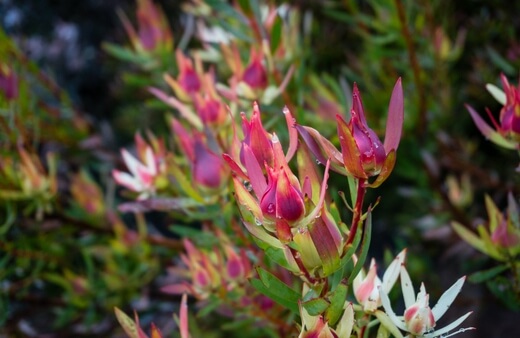
Family: | Proteaceae |
|---|---|
Genus: | Leucadendron |
Species: | Various |
Origin: | South Africa |
Common Names: | Leucadendron, conebush |
Location: | Outdoor |
Type: | Shrub |
Growth: | 1 to 7 metres tall and up to 2 metres wide |
Sun requirements: | Full sun to light shade |
Foliage Colour: | Green |
Flower Colour: | Bright flower bracts that vary in colour depending on variety |
Flowering: | Winter to spring |
Fruit: | Pods full of edible seeds |
Maintenance level: | Low |
Poisonous for pets: | All parts are toxic if consumed |
Getting to Know Leucadendron
With elliptical evergreen leaves that form on charmingly upright branches, each adorned with brightly coloured blooms that range from creamy red to deep purple and white to pink, leucadendron shrubs are truly ornamental additions to any outdoor space.
The blooms form in dense inflorescences which are long-lasting, usually from early winter through to mid-spring, offering growers enduring beauty within their gardens. Furthermore, the eccentric bracts will make for gorgeous cut flowers whether fresh or dried, offering a long vase life much like their close relatives, the Protea.
There is little reason not to consider growing a leucadendron and we’ll explain everything you need to know to make the process as rewarding for you as possible.
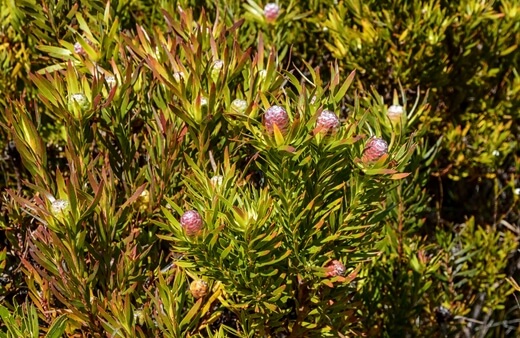
Leucadendron Plant Details
Forming a part of the infamous Proteaceae family of plants, Leucadendron or conebushes are endemic to South Africa where they are a prominent part of the fynbos ecoregions of the country. The ‘silver tree’ variety inspired the genus name which means “white tree”.
Interestingly, these are some of the few plants in the family that are dioecious with separate male and female specimens. Male plants are typically more branched than females and often produce larger flowers but smaller leaves and cones.
Conebush Growth Habits
These shrubs, much like many of our native shrubs, prefer subtropical to warm temperate climates which perfectly suit most Australian garden conditions.
For those who live in cooler regions, leucadendrons can be reliably grown in containers and overwintered indoors. Alternatively, they can be treated as annual additions to cold gardens.
Cultivated within residential gardens and conditions, conebushes will usually reach between 1 to 7 metres tall and up to 2 metres wide with a fast growth rate. However, this can vary depending on the species, variety or cultivar being established.
Leucadendrons will attract a large variety of birds as well as bees and butterflies.
Common Landscaping Applications
- Coastal gardening
- Mass plantings
- Feature plant
- Border planting
- General shrubbery
- Container gardening
- Cut flowers in arrangements, both fresh and dry
Plant with Australian native ornamental grasses or succulents for added texture. Alternatively, plant alongside other Australian flowering shrubs like Banksias, Grevilleas, Hakeas or Waratahs.


Get Your Free Guide:
Master Growing Australian Natives eBook
A Must Have Complete Guide for Every Australian Garden
Get Your Free Guide:
Master Growing Australian Natives eBook
A Must Have Complete Guide for Every Australian Garden
Just be sure to leave each shrub enough space to grow and receive adequate air circulation.
How to Grow Leucadendron
Best Planting Conditions for Leucadendron
Leucadendrons are prized by gardeners for their low-maintenance requirements, especially when given good conditions to grow in. Their growing needs are uncomplicated yet essential to allowing the shrubs to flourish and produce vivid blooms that can last for most of the year.
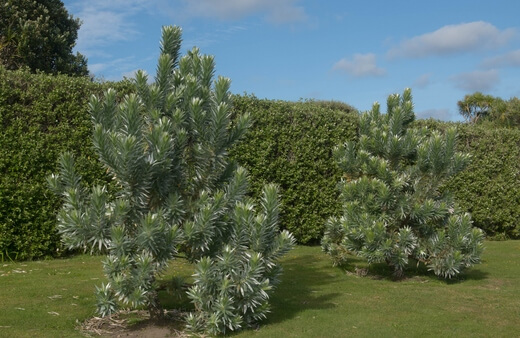
Soil
Conebushes prefer well-draining, slightly acidic soil with an ideal pH level of 6-7 or lower. While they can tolerate poor and salty soils, it is best to add some pine needle mulch and sulphur to acidify weaker soils.
Raised garden beds are also recommended to ensure adequate drainage and nutrient intake. For potted shrubs, a high-quality potting mix is perfect.
You can find a quality soil tester here.
Sunlight
As with many flowering shrubs, conebushes will also thrive in open and sunny positions in the garden with good air circulation. Ideally, they should receive bright light for at least 6 hours a day.
Though leucadendrons can tolerate some shade, flowers will be less vivid in colour the more shade that is received. As a general rule of thumb, the more sun, the more flowers will bloom.
Growing Leucadendron in Pots
Conebushes can be grown successfully in containers where their size can also be managed more effectively for establishing smaller specimens. In cooler regions, it is recommended to grow the shrubs in containers so they can be overwintered indoors.
Just try to use a quality potting mix and provide adequate sunlight to potted shrubs and they should thrive.
Quick Tips
Gardeners should avoid overcrowding leucadendrons with other plants as they need a healthy amount of space to grow properly and avoid disease. If you do choose to group a couple of shrubs, leave about 1.5 metres of space between them.
Lastly, while humidity can be beneficial, overly humid environments can damage your shrub. General garden humidity in the correct climates should be ideal.
How to Propagate Leucadendron
Conebushes are reliably propagated using semi-ripe stem cuttings or seeds.
Stem cuttings are the preferred method to grow the most uniform offspring as seeds tend to produce fewer true-to-type specimens. Seed-grown plants will also take up to 3 years to start flowering whereas cuttings will flower far sooner.
Viable seeds can be collected from ripe female fruit cones after flowering or purchased online or at reputable retailers. Cuttings should be taken from disease-free parent plants just after the active season growth.
Propagating Conebushes Using Stem Cuttings
- Using a sharp and sterilised pair of secateurs, take a semi-ripe stem cutting of about 10 cm to 15 cm in length.
- Prepare a well-draining propagation container filled with high-quality potting soil mixed with some organic compost.
- Lightly water the mix before planting.
- Dip the cut end of the cutting into a quality rooting hormone then place it into your mixture to a depth of around 5 cm to 7 cm.
- Water well then place the cutting in a brightly-lit warm location with decent humidity.
- Keep the mixture moist but never wet while your cutting establishes new roots.
- Once new growth has started developing and the cutting is settled in the next active season, you can transplant it into a larger container or your garden bed.
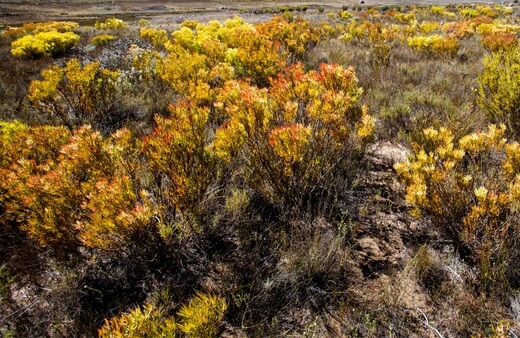
Propagating Leucadendron Using Seeds
- Sow your seeds around the spring or autumn seasons for the best results.
- Prepare seedling containers filled with a high-quality propagation medium that has good drainage.
- Sow seeds as deep as their size and water in well.
- You can optionally cover the seeds with a light mixture of vermiculite to help with retaining moisture and controlling temperature.
- Place the seeds in a warm and sheltered location indoors. Some indirect light can help with germination.
- Water when the growing mixture is drying out.
- Ideally, seeds will need warm days and cold nights to germinate.
- Germination should take about 21 to 60 days depending on conditions and temperatures. However, some varieties can take as long as 6 months to germinate so some patience may be required.
Caring for Leucadendron
Once established, these hardy shrubs are very tolerant to drought and wind but they do not enjoy hard frosts. Generally, they will be able to tolerate temperatures down to about -5°C so if you experience colder winter conditions, it would be best to grow your shrub in a container for overwintering.
Here are some basic care instructions to ensure your conebush thrives.
Watering Schedule
Thanks to their drought-tolerant natures, leucadendrons only need to be regularly watered during particularly dry periods once established, making them excellent picks for water-conscious gardens. They will require regular watering during the first 12 months of establishment.
On average, water deeply about once per week during dry periods and flowering. Potted shrubs will need to be watered more often. When watering, it is important to avoid wetting the foliage and water at the base of the plant.
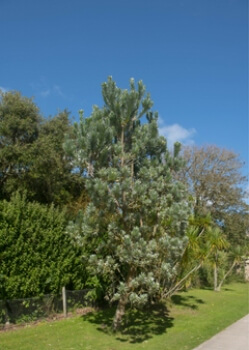
Pruning Leucadendron
Prune after flowering to help maintain the size and shape of your shrub. Try to avoid pruning during cold periods which will help to avoid frost-tender growth. Ideally, pruning should be done around mid-spring for the best results.
If needed, you can hard prune these shrubs and cut away a large amount of foliage.
Fertilising
Conebushes don’t necessarily need fertiliser as the roots absorb nutrients quickly. However, they can benefit from small amounts of organic slow-release fertiliser or native plant fertiliser during the active seasons.
Be sure to use a fertiliser that is lower in nitrogen and phosphorus and higher in potassium as these shrubs are sensitive to phosphorus specifically.
Mulching
Mulching is essential for retaining healthy moisture levels in the soil and it will also help suppress weeds around the plant. Mulch with a thick layer of organic mulch about once to twice a year during the warmer months.
Be sure to leave some space around the main stem to avoid suffocation and water the mulch in well.
Leucadendron Pests, Problems and Diseases
Leucadendron shrubs are generally troubled by very few pest or disease issues, especially when given sufficient space for air circulation. The one major problem these plants face is root rot, which can be a little difficult to control. With any rot, prevention is always the most ideal option.
Root rot can be prevented by ensuring healthy air circulation throughout the shrub, ensuring it is growing in well-draining soil, avoiding overwatering, pruning sufficiently, and always cleaning your pruning tools to avoid any infected material or soil debris from entering your plant.
Root rot will cause your shrub growth to severely slow down. It can also cause mushy stems and wilting yellow or distorted foliage. The soil around the plant will also start to smell a little rotten and the roots can turn reddish-brown.
These are all good indicators that your plant may be suffering from root rot.
Here are some ways you can treat root rot and help your plant recover:
- Cut back on your watering for some time to allow the soil to dry out.
- Remove infected portions of the plant where possible.
- Repot or transplant into fresh soil in severe cases.
- Lightly prune your shrub regularly to decrease water demands.
- Remove all browning leaves and cut away dead and decaying roots where possible.
- If possible, rinse the roots under fresh water.
- Once your shrub starts recovering, feed with some fertiliser and resume your usual watering schedule.
Our Favourite Leucadendron Varieties
Leucadendron argenteum
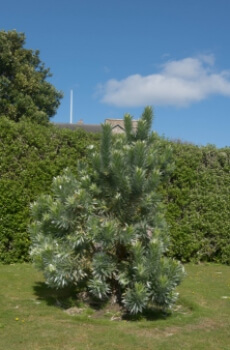
Commonly known as silver tree, this species is one of the most commonly grown in the genus. It grows up to 7 metres tall and features stunning silvery foliage and yellow flower bracts.
Leucadendron galpinii
Known as Galpins conebush or hairless conebush, this special species is noted for its decorative silver seed cones, silver-green foliage and spirally arranged bracts. Growth is around 2.5 metres tall and 2 metres wide.
Leucadendron salignum

Commonly known as the sunshine conebush, this species is one of the most cultivated and cross-bred in the genus. It features burgundy flower stems with bracts that open to pinkish-white in winter. It grows to a height of 2 metres.
Leucadendron gandogeri
A cheerful species that is commonly known as the broadleaf conebush. It reaches 1.8 metres tall and 1 metre wide. Great for pots, this shrub produces vibrant green foliage with masses of yellow flowers in early spring.
Leucadendron laureolum

Commonly known as the golden conebush, this species grows to about 1 to 2 metres tall and wide with a rounded and compact habit. It is cherished for its bright yellow blooms that sit atop gently arching stems with soft-green leaves.
Leucadendron discolor
Known as the Piketberg conebush, this species is unfortunately threatened by habitat loss in its natural environment. It produces distinctive grey-green, broadly ovate leaves and creamy-yellow flowers with vivid red centres. Growth is up to 2 metres.
Leucadendron strobilinum

Commonly called the peninsula conebush, this species is a larger single-stemmed shrub that branches gracefully from the base. It reaches 3 to 4 metres tall and features dark-green oval leaves with red tips in the bracts.
Leucadendron stelligerum
Known as the Agulhas conebush, this unfamiliar species grows to 2 metres tall and features lovely whitish pink flowers that can add gorgeous tones to outdoor spaces in the cooler months. The ‘Harvest’ cultivar is a great pick for pots.
Leucadendron ‘Safari Sunset’
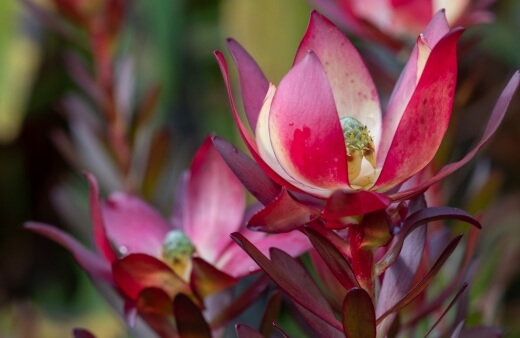
An award-winning cultivar that grows up to 3 metres. It features rich deep-red floral bracts adorned with buttery-yellow blooms.
Leucadendron ‘Purple Haze’
This showy cultivar grows up to 1.5 metres tall and features silvery purple-coloured foliage with silver cones during Christmas.
Leucadendron ‘Devils Blush’
A hybrid that grows to 1 metre tall and wide. It produces lovely blue-grey foliage that turns red from autumn to spring with white bract centres.
Leucadendron ‘Sundance’
Another beautiful hybrid that grows to 1.5 metres tall and wide. It produces bright green foliage with vibrant red tips and pale-yellow flowers.
Leucadendron ‘Cheeky’
Perfect for growing in pots, this hybrid reaches around 60 cm tall. It features fine vibrant red foliage and bracts with a light rose scent.
Leucadendron ‘Strawberries and Cream’
Growing to 1.5 metres tall and wide, this plant produces gorgeous pink foliage with white centres.
Leucadendron ‘Red Gem’
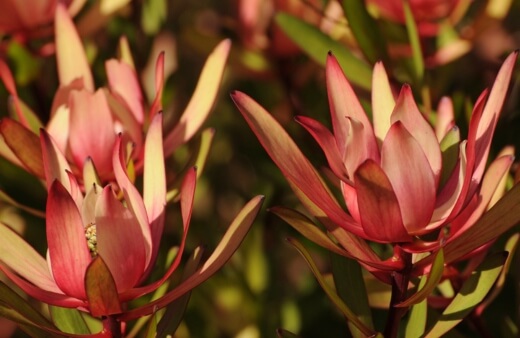
An impressive hybrid shrub that reaches up to 2 metres tall. It sports bronze-red flowers that open up to a soft yellow with red bracts.
Leucadendron ‘Safari Gold Strike’
A vigorous and compact shrub growing up to 2 metres. Famed for its brilliant golden-yellow bracts atop luscious green foliage.
Leucadendron ‘Jester’
Named for its showy colours of bright pink, cream and green, this cultivar grows to about 2 metres tall. Enjoy rich red bracts atop branches of variegated foliage.
Leucadendron ‘Jack Harre’
Bred by notorious horticulturalist Mr Jack Harre, this stunning hybrid sports exquisite flowers of buttery yellow with flame-red bracts. Grows to 1.5 metres.
Leucadendron ‘Jubilee Crown’
A very unique hybrid that is covered in marble-sized reddish-pink cones with silvery green foliage. Grows between 1.5 and 2 metres tall and wide.
Leucadendron ‘Summer Sun’
This highly decorative rounded shrub grows to a compact 1 metre tall and wide, perfect for container gardening. It flaunts masses of bright yellow flowers with red centres, encapsulated by star-like floral bracts.
Leucadendron ‘Misty Sunrise’
A lovely compact cultivar growing to 1.5 metres tall and 1 metre wide. It is perfect for hedging and borders, sporting blue-grey foliage that turns vibrant red from winter to spring.
Leucadendron ‘Royal Ruby’
With decorative foliage that turns yellow in winter with attractive red centres in spring, this shrub grows to 1.5 metres tall and wide and is great for small hedges or mass plantings.
Leucadendron ‘Golden Mitre’
Prized for its golden-coloured foliage from autumn to spring, this plant also grows to 1.5 metres tall and wide.
Leucadendron ‘Yellow Countess’
Another beautiful hybrid that produces an abundance of yellow bracts in winter. Grows to about 1 metre tall and wide.
Leucadendron Frequently Asked Questions

What is the difference between protea and leucadendron?
Though related, the main difference is that proteas produce big flower heads whereas leucadendrons produce coloured bracts. Proteas are also much more common in floral arrangements and florists.
Are leucadendrons hardy?
Overall, these shrubs are considered hardy and adaptable in subtropical to warm temperate garden conditions. They are frost hardy to about -5°C and can tolerate drought well.
What problems do leucadendrons have?
They do not enjoy wet feet and poor air circulation which, if not managed correctly, can lead to root rot and even instant death. Furthermore, they tend to struggle in heavy clay soils and high pH conditions.
Ideally, the soil pH level should be 6 or lower. Higher pH soils can be acidified with coconut coir or pine bark and sulfur.
Where is the best place to plant leucadendron?
These flowering shrubs perform best in sunny and open positions in the garden. They also prefer raised beds so try planting them on a slope or mound about 30cm high.
How long does leucadendron last?
Depending on the species or cultivar, leucadendron cut flowers will last between 2 to 6 weeks in freshwater with an average vase life of around 26 days. Flowers should be harvested closed and will open during the following days when placed in water.
Do leucadendrons have invasive roots?
The root systems are considered non-invasive.
Are leucadendrons fast growing?
Yes, these bushy shrubs are generally considered fast-growing in good conditions. They may grow at a slower rate in shadier, cooler conditions.
Can you keep leucadendrons small?
There are a couple of ways to keep these shrubs small. You can cut the plant down pretty drastically as long as there are still leaves on each stem. Alternatively, you can grow them in pots to reduce their mature size.
Can leucadendrons grow in part shade?
While they do prefer full sun, they can tolerate part shade. However, the shrub may produce fewer blooms that are less vivid in colour.
Interested in learning how to grow some of our Australia's showiest native shrubs? Check out some of our informative guides below for more information:
Elevate Your Gardens Wintry Wonder with Leucadendron
Leucadendron shrubs are cool season stunners that can add long-lasting spectacle to gardens throughout winter and into spring. With their low-maintenance requirements, colourful blooms and a large selection of varieties and select cultivars to choose from, growers are spoilt for choice and beauty here.
Leucadendron is also perfectly suited to most Australian gardens, where they will look stunning planted alongside some of our favourite native flowers, shrubs and ornamental grasses.
Published on March 31, 2023 by Lorri Hopkins
Last Updated on September 20, 2025




